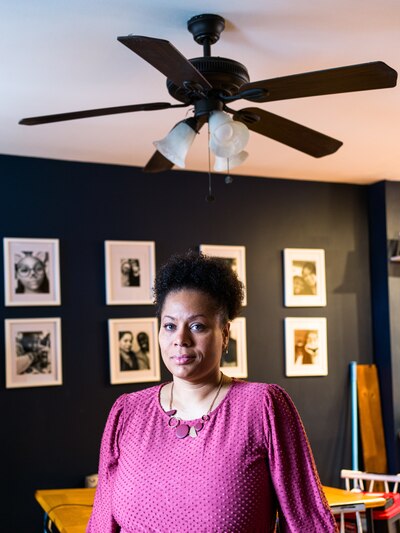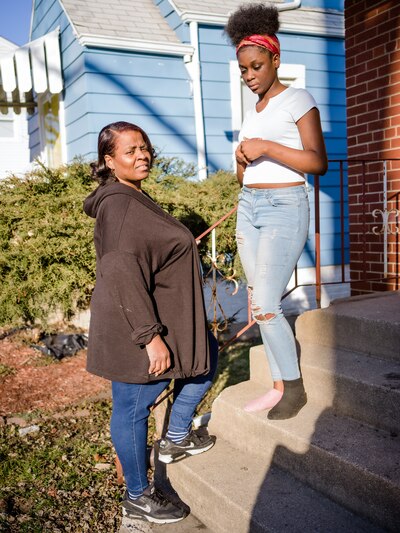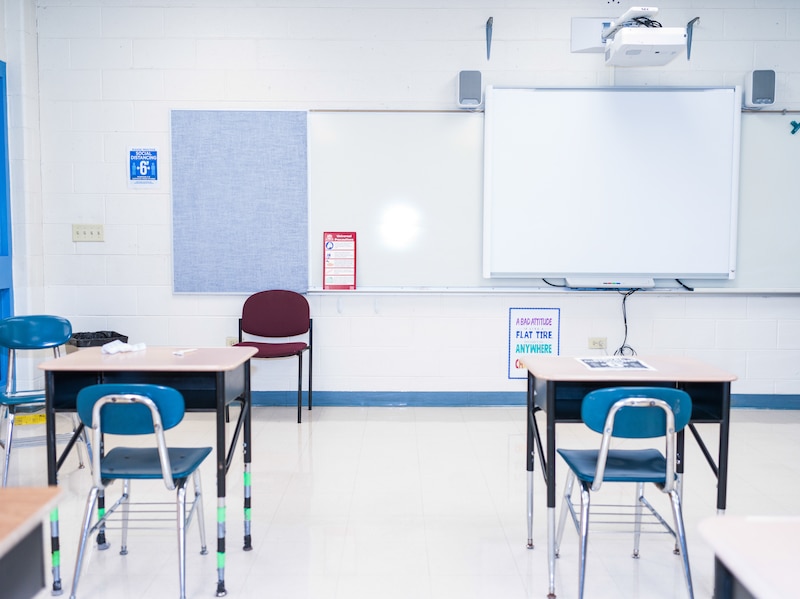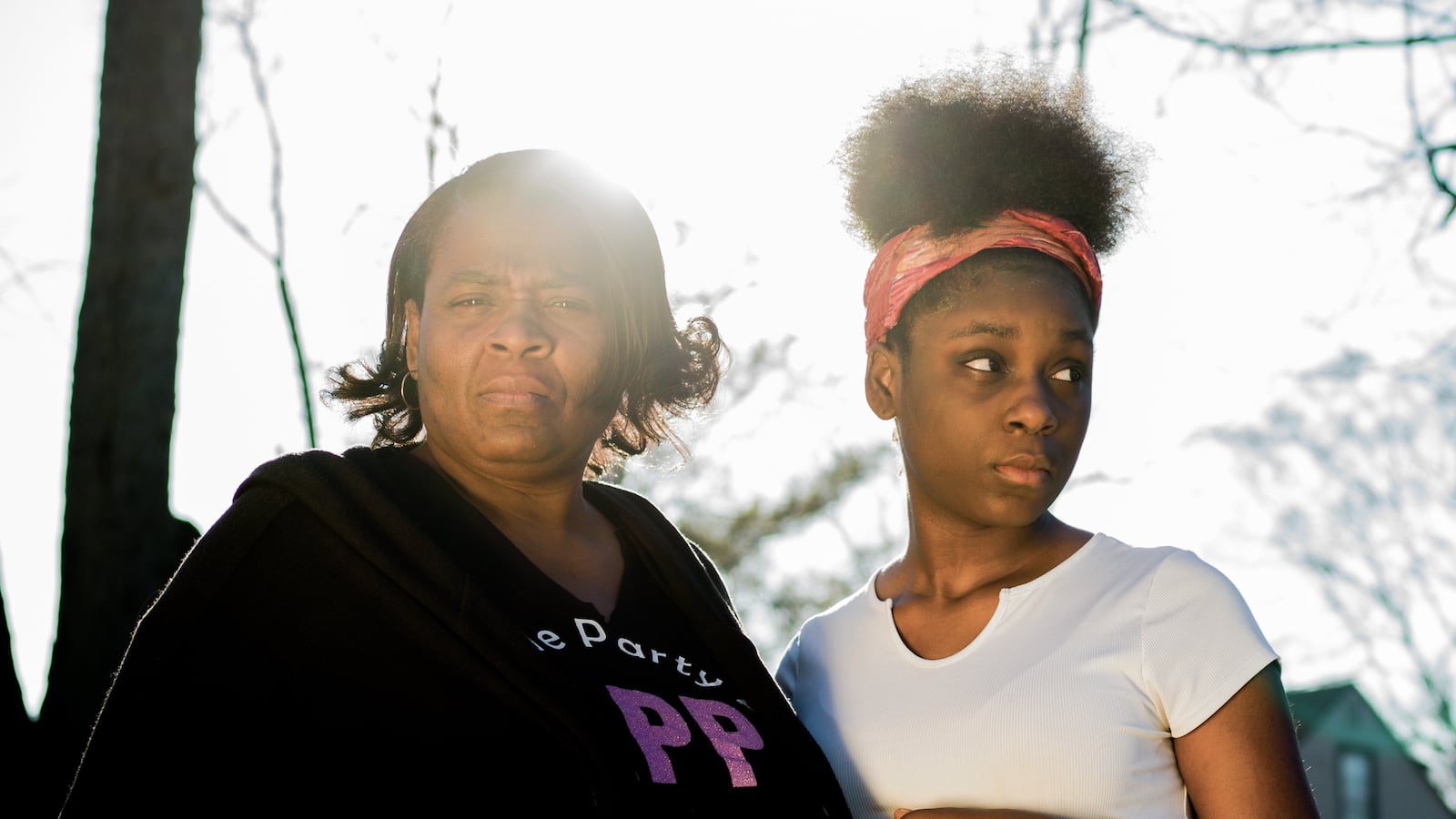Angela Grier is determined to give her daughter Marnina the one thing she wants more than anything: an eighth grade graduation ceremony, in person.
Marnina’s school is planning to hold its official ceremony online, and Angela didn’t want her youngest child to head off to high school with so little fanfare. So she’s going to rent a small venue and borrow a podium. There will be a column of balloons and, hopefully, a few friends. And Marnina will walk across a stage and get her diploma.
“You’ve got to do something for these babies,” Angela said. “They’ve been through so much.”
For Marnina, that “so much” has been a year of remote school that’s looked like a lonelier semblance of her former life. Zoom classes last six hours a day, and she doesn’t talk much with classmates, especially without her cheerleading squad or track team. There have been a few meltdowns and mental health breaks.
Marnina knows that the next few months of school won’t look much different. Officials in her small school district in south suburban Chicago, Dolton West, recently made the call not to reopen buildings at all this school year.
Nationally, that makes the district of 2,100 students an outlier. A year into the pandemic, more schools are reopening their doors for in-person learning every week. Others plan to follow soon. State and federal pressure to do so is mounting. By one estimate, only one in six students nationwide attends a district where schools are still fully remote.
The reasons why Dolton West chose not to reopen school buildings are complex, but boil down to this: School leaders wanted to reduce uncertainty during an unpredictable year in which Black communities like theirs have borne the brunt of a deadly virus. Here, there’s been no public clamoring for schools to reopen. A few other school districts in the area, including one where Marnina will attend high school next year, made the same call.
Supporters of the decision say school officials are doing what most families wanted and prioritizing the safety of school staff who have had limited access to the vaccine — instead of bowing to pressure from politicians and public health officials who have a limited understanding of Dolton, its schools, and its families.
But that choice has brought hardship, too, particularly for students, and families are more divided about reopening than district officials have let on. It’s an illustration of just how fraught decisions about schools and safety have been this year in every corner of the country, not just places with high-profile reopening battles.
For one Black community, an early decision
On a Tuesday in late February, the disembodied voice of a Dolton West school board member called their virtual meeting to order, launching a monthly ritual that began nearly a year earlier. That evening, the board had a particularly high-stakes question on the agenda: whether students should return in-person.
Superintendent Kevin Nohelty ticked through his rationale. Virus rates were falling, but concerns about new COVID variants were growing. Few in their community had gotten the vaccine. Survey results were in, and most families and staff who replied wanted to stick with remote learning.
“I want to make sure that I’m doing what I believe is the best for our community,” he would later say.
Several board members agreed. But Kim Adkins, who has four grandchildren in the district, was vocal about her concerns. Almost nine in 10 students qualify for free and reduced price meals in the district, and most students lagged behind their peers statewide in reading and math before the pandemic. She worried staying virtual would compound existing disparities.
“I think our younger children need to be together to have their social development,” she said. “Let’s be honest with one another that this is not helping our children at all.”
Nohelty promised that plans for summer school, likely with an in-person option, would be coming soon. Adkins came around, and the board’s vote to stay remote for the rest of the school year was unanimous.
Safety wasn’t the only argument Nohelty made. He also felt the district’s virtual instruction was strong and engaging, and he and other educators worried switching to part-time in-person school would disrupt that. Elsewhere, when school districts have reopened part-time, it’s often meant a chaotic experience that educators say especially shortchanges remote learners. Nationally, parents with that setup have been the most dissatisfied with the quality of their children’s education.
“There is so much going on all around us,” Nohelty said later. “The one thing that I had the most control of is how we deliver that instruction.”

School leaders don’t always get to make that call. In at least seven states, officials are compelling districts to reopen their doors. Illinois is not among them. So here, in a school district where 94% of students are Black, as are more than half of teachers, the decision fell to a superintendent who saw remote learning as the path to providing safety and consistency, and a school board that trusted the superintendent and did not want the community to shoulder any additional risk of spreading the virus.
But for all the uncertainty that decision erased, there were other doors it closed — like the ability to adapt during a fast-changing public health crisis. Across the country, other school districts have changed up their reopening plans many times over as more educators have gotten access to the vaccine and officials have struck deals with teachers unions. It’s unclear what would have happened in Dolton West because the two sides never reached the negotiation table.
“There’s still a lot of hesitancy, but our teachers are very dedicated,” said LeShele Silas-Armour, the head of Dolton West’s teachers union. She supported the decision to stay remote, but thinks if the board had decided to bring students back, educators could have reached an agreement. “If our employer says we have to go back, you have to go back.”
Many parents chose remote learning
A chorus of public health experts say the district’s caution is unwarranted. The Centers for Disease Control and Prevention has said even where transmission is high, schools can safely offer in-person instruction with the right precautions. The new federal stimulus packages mean districts should have the money they need to add safety measures like COVID testing, and Education Secretary Miguel Cardona is pushing schools to open quickly.
“We know there are inequities to in-person learning,” Cardona said recently, pointing to new federal data that show many fewer Black, Hispanic, and Asian students are going to school in person five days a week. “America, that is our charge: to safely reopen schools as quickly as possible.”
Federal education officials have said little about how they plan to engage with school districts that aren’t reopening, though Cardona is expected to visit some schools that have faced “roadblocks and challenges” on an upcoming national tour.
But to Sugar Robinson, Dolton West’s decision is a sign that the district listened to families like his. He was among the two thirds of families who recently told the district they preferred to stick with remote learning through May. He doesn’t want his sons going back into school buildings until the fall, and wants the district to use the summer to prepare.
“It doesn’t make any sense to rush the children back to school when they’ve already been out half the year,” he said. “What is a little bit more time being patient?”
The district has spent tens of thousands of dollars on additional cleaning, air purification systems, and fever detection cameras. Even so, some parents told Nohelty no amount of safety precautions would persuade them while the pandemic was still a threat.
“It’s scary,” said Diannese Dokes, a parent who has five children in the district. She wanted her kids to stay remote for safety reasons, even though she was unsatisfied with the quality of their remote lessons and was frustrated by the laptops the district provided. “It’s kind of hard to even say what would make me comfortable.”
Perhaps a third of families wanted some in-person learning, a recent survey showed. But they weren’t an outspoken contingent. No parents spoke out against the plan to stay remote at the board meeting. Just one sent an email to register their concerns, Nohelty told the board.
The wariness of Black parents to return to in-person school has shown up time and again on national polls. They’ve been much more likely to say schools should weigh the health risks to students and teachers when making school reopening decisions. Black parents have also been much less likely than Hispanic or white parents to choose in-person learning when it’s offered.
Dr. Theresa Chapple, an epidemiologist who’s advised more than two dozen school districts about their pandemic operations, notes that the school reopening calculus hasn’t looked the same in mostly Black and Hispanic communities where the death toll from COVID has been higher and parents had concerns about school safety and cleanliness before the pandemic.
Years of systemic racism and under-funding of schools has contributed to Black parents’ distrust. Until recently, Illinois had one of the most inequitable school funding systems in the country, and Dolton West schools were among the most under-funded in the state.
“If we’re talking about weighing the risk versus the benefits, we need to realize that that looks different depending on who’s on the scale,” Chapple said.
It’s also true that the district didn’t have a great sense of what families wanted. Like many districts, it struggled to get answers, and only around a quarter of the district’s families responded to its survey. It also didn’t wage the kind of all-out recruitment efforts that some schools have to convince hesitant families of the safety of in-person learning.
Things might have shifted notably over the spring, too. Some districts that serve large percentages of Black students, such as Detroit, have seen the share of families opting into in-person learning increase with time as parents see the precautions schools are taking firsthand.
It’s clear, though, that many Dolton parents think the decision was the right one.
“Since my kids have been out of school,” Dokes said, “none of us has gotten sick.”
The tradeoffs of remote learning
Early in the pandemic, Robinson, like so many others, lost his job. He went from tending the grounds of a Chicago cemetery — where he helped bury one of the last Tuskegee Airmen — to spending his days overseeing his sons’ remote education.
Over the last year, he’s seen his sixth-grader, a focused but shy honor roll student, start to speak up in class in a way he hadn’t before. “He’s starting to open up a little bit more … being more interactive in the class, because he doesn’t feel intimidated,” Robinson said. “That’s a good thing.” And Robinson was able to keep a closer eye on his fourth-grader, Seth, when classes were online. When he noticed Seth was struggling in math and reading, he was able to come up with a game plan with Seth’s teacher.
Robinson is grateful to the district for all it’s done during the pandemic, including giving his son a coat and gift for Christmas. But he knows it would be harder if he was working outside their home.
“This is like a full-time job and it feels like I’m in school too,” he said. “You have to be involved in order for it to work.”
Overall, though, his two sons have done well. Seth’s model windmill even won top honors in the district’s virtual science fair this winter. As Seth explained the difference between independent and dependent variables to a virtual crowd, turbines whirring and cotton ball clouds hovering near his face, Robinson beamed.
Marnina, on the other hand, has spent the last several months holding out hope she’d get to go back to school — and feeling frustrated the district didn’t change course as many students struggled.
She was among them. In the past, she mostly got As. But this year, her GPA has fallen as she’s found it more difficult “to keep up with everything and keep focused.”
She wakes up early three days a week to take a virtual advanced math class through her local high school — encouraged by her grandfather, who wants more Black women to have opportunities for careers in math, science, and engineering. But she’s sometimes gotten tripped up in her eighth grade math class. When she struggled with a recent homework assignment, Marnina said, she emailed her teacher but didn’t hear back for days. She ended up scouring YouTube for help instead.
Her peers are all over the map. During the school day, she watches the number of students in her class fall, starting at 20 and usually ending with 14 or 15. Two of her friends are thriving online, but some are failing most classes.

“Once I hear them say ‘Oh, I’m ready to drop out,’ I tell them: ‘Think about the future,’ and things like that,” Marnina says. “What are you going to do when you get older without an eighth grade diploma?”
And with Marnina’s social world constricted, Angela has been keeping a close eye on her daughter’s mental health. She became alarmed when Marnina, who in any other year would be active with sports and student council, wanted to sleep all day. On especially tough days, Angela has allowed Marnina to turn off the computer and take a mental health break.
“You’re still in the house 24 hours a day,” Angela said. “That’s hard on anybody.”
Dolton West officials have tried to combat students’ social isolation with virtual mental health counseling and after-school activities. Silas-Armour, for example, runs a virtual club where students can hear women of color speak about their career paths, from being a state’s attorney to an engineer.
But Nohelty knows those are only “parachutes,” and he’s working with a team of educators on a plan to address the social and emotional needs of students and staff next school year, including by hiring more social workers.
“I am clearly aware that this has taken a toll,” he said.
Rising student stress and anxiety aren’t limited to districts that haven’t opened buildings at all, of course. In many districts that have reopened, huge swaths of students have opted not to return. In New York City, for example, 70% of students have chosen to remain remote. Many of the stresses of the pandemic — fear of infection, job losses — have little to do with where students are going to school.
Still, at least some teachers wished Dolton West had left the door open for compromise to reach students who need in-person support the most.
Tiffany Bennett, who works with junior high school students who’ve fallen behind in math or reading, feels that way. At first she was reassured by the results of students’ fall diagnostic tests, which showed that students hadn’t lost much academic ground since school went remote last spring. But as the year has gone on, her concerns have grown.
She’s seen some students take “nose dives” on assessments, and she can’t tell if it’s due to waning motivation or missing skills. Some students are skipping her class, sending her on a digital hunt to find them. Of the 30 students on her caseload in January, six had “iffy” attendance. It wasn’t clear if two were still enrolled at all.
And it’s gotten harder for her to help her students, too. Video delays can make it hard for struggling readers to hear her as she sounds out words. Sometimes she’s not able to do more than chat with her students over the computer because it’s so loud where they are.
“They’re already behind,” she said. “I think we’re just getting further behind.”
A trial run this summer
District officials haven’t officially committed to offering fully in-person learning this fall, but they’ve signaled that is their plan. Whether they’re able to make that a reality for families — and their plan to support students who will have been away from their classrooms for nearly a year and a half — will have big consequences.
Dolton’s challenges to reopen this fall will be particularly difficult, as they haven’t yet had opportunities to build trust with families and educators about the ways they’ll keep schools safe.
This summer will mark their first trial run. Officials are planning to offer in-person summer school for students who want it, plus in-person arts and music programming. A team recently met to review in-person safety protocols.
The slow pace of vaccination is picking up, and by fall all school staff who want shots should be able to get them. A mass vaccination site recently opened in the area, and Nohelty is texting Silas-Armour whenever he learns of open appointments to try to get teachers those slots.
The question now is how many families will choose in-person learning, and whether the district will be able to make up for what students went without this year.
“We know that there is going to be a gap,” Silas-Armour said. Teachers are “hoping, fingers crossed, that parents want to enroll their kids in summer school so we can start on that right away.”

In that way, Dolton West’s challenges are shared by nearly every district in the country, as educators everywhere see their students didn’t get all of what they needed this year — whether they went back fully in person, for a few days a week, or stayed fully virtual. Many have concerns about what it will take to help students learn what they missed, in a year that saw a dramatic uptick in course failures and lower school participation rates nationwide.
“I don’t know what that’s going to look like when it’s time for them to go back to school,” Adkins, the school board member, said. “It just hurts my heart.”
For Marnina, when she looks back on her year, this is what she’ll remember.
Her first C. The poem she wrote about civil rights protests that her teacher used as an example in class. The Excel spreadsheet she made to track her assignments. The frustration she felt when she realized she’d never graduate eighth grade in the way she imagined. That nagging question in the back of her mind: Did I learn enough this year?
And the mix of excitement and nerves she feels when she thinks about starting high school — with the prospect of a fresh start.


